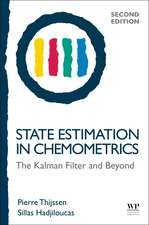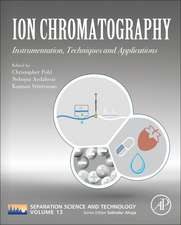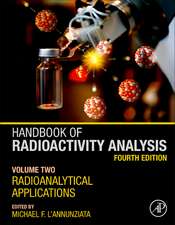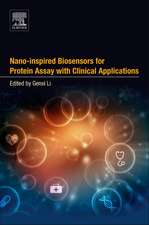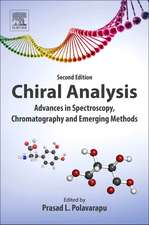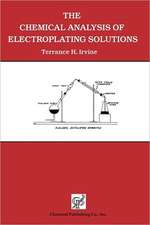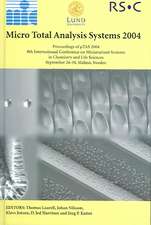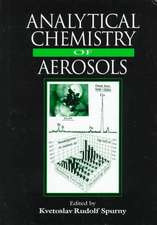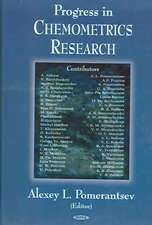Particulates Matter: Impact, Measurement, and Remediation of Airborne Pollutants: Emerging Issues in Analytical Chemistry
Autor Vikram Rao, William Vizueteen Limba Engleză Paperback – dec 2020
Particulates Matter: Impact, Measurement, and Remediation of Airborne Pollutants offers a high-quality reference guide to PM that will greatly benefit technology leaders in environmental compliance groups, epidemiologists and other public health professionals focused on pollution and health, and researchers and scholars working in pollution, climate change, and urbanization. It may also be useful to advanced undergraduate and early graduate students in environmental sciences.
- Includes a summary of the current knowledge on nanoparticles as pollutants and their negative health effects
- Provides a framework for the evolution and maturation of air pollution characterization and mitigation
- Describes an integrated set of engineered solutions that account for the concatenated relationships between technology, policy, and society necessary for long-term success
Preț: 617.33 lei
Preț vechi: 793.66 lei
-22% Nou
Puncte Express: 926
Preț estimativ în valută:
118.13€ • 123.65$ • 98.32£
118.13€ • 123.65$ • 98.32£
Carte tipărită la comandă
Livrare economică 24 martie-07 aprilie
Preluare comenzi: 021 569.72.76
Specificații
ISBN-13: 9780128169049
ISBN-10: 0128169044
Pagini: 288
Ilustrații: 60 illustrations (10 in full color)
Dimensiuni: 152 x 229 mm
Greutate: 0.39 kg
Editura: ELSEVIER SCIENCE
Seria Emerging Issues in Analytical Chemistry
ISBN-10: 0128169044
Pagini: 288
Ilustrații: 60 illustrations (10 in full color)
Dimensiuni: 152 x 229 mm
Greutate: 0.39 kg
Editura: ELSEVIER SCIENCE
Seria Emerging Issues in Analytical Chemistry
Public țintă
Analytical chemists and environmental chemists working in environmental health and compliance groups; energy companies and vehicle manufacturers; epidemiologists focused on pollution and health and other public health professionals; NGOs working on indoor and outdoor air pollution; think tank scholars working in pollution, climate change, and urbanization; advanced undergraduate and low level graduate courses in environmental sciencesCuprins
Part I: PM and ozone fundamentalsChapter 1. Why particulates matterChapter 2. Principal sources of PMChapter 3. Ozone: Good high, bad nigh
Part II: Impacts of differences in particle sizeChapter 4. The importance of being smallChapter 5. Health effects of airborne particulates
Part III: Methods for measuring PM and estimating health effectsChapter 6. Detection and evaluation of airborne particulatesChapter 7. Estimation of toxicity of airborne particulates
Part IV: Engineered solutions for PM amelioration and eliminationChapter 8. Wood fires: DomesticatedChapter 9. Wood fires: WildChapter 10. Reducing PM and NOx in diesel engine exhaustChapter 11. Alternative fuelsChapter 12. Electric vehicles: Transformational solution for low-PM transportation Chapter 13. Clean coal and dirty solar panels
Part V: Charting the future for research and policyChapter 14. Research and policy directions
Part II: Impacts of differences in particle sizeChapter 4. The importance of being smallChapter 5. Health effects of airborne particulates
Part III: Methods for measuring PM and estimating health effectsChapter 6. Detection and evaluation of airborne particulatesChapter 7. Estimation of toxicity of airborne particulates
Part IV: Engineered solutions for PM amelioration and eliminationChapter 8. Wood fires: DomesticatedChapter 9. Wood fires: WildChapter 10. Reducing PM and NOx in diesel engine exhaustChapter 11. Alternative fuelsChapter 12. Electric vehicles: Transformational solution for low-PM transportation Chapter 13. Clean coal and dirty solar panels
Part V: Charting the future for research and policyChapter 14. Research and policy directions
Recenzii
"This well-crafted book covers broad swathes of contemporary air pollution science, public health and policy with a select and authoritative bibliography. The authors expertly distill accurate scientific detail into readily understandable concepts while maintaining excellent balance. Readers are led on an enjoyable path from the source, composition and health impact of airborne particulates through some of the mainstays of aerosol physics, atmospheric chemistry, good and bad ozone, to the history and implications of climate change. Attention is paid to emerging issues such as wildland fires amidst the backdrop of household biomass burning in the developing world; the emergence of SARS CoV-19; and other potential vulnerabilities associated with poor air quality. The book also provides excellent descriptions of the internal combustion engine, energy generation from fossil fuels and "renewables", and the control technologies associated with these processes. Interesting vignettes peppered throughout the volume describe real-life examples of the subject at hand in a more conversational manner that enhance the readability. This book is an excellent primer for laypersons and scholars alike who wish to know more about the sources, environmental fate and public health implications of airborne particulates and other pollutants from both local and global perspectives." --M Ian Gilmour Ph.D, DABT, Chief, Cardiopulmonary and Immunotoxicology Branch, Public Health Integrated Toxicology Division, Center for Public Health and Environmental Assessment, Office of Research and Development. U.S. Environmental Protection Agency













